Rock Samphire – Identification, Edibility, Distribution
Crithmum maritimum
Rock samphire should not be confused with its better known, but unrelated namesake marsh samphire. Learn about marsh samphire here.
- Edibility – 3/5 Leaves, flowers, seeds. A pungent , succulent member of the carrot family. Rich in aromatic oils which some people say taste like kerosene!
- Identification -4/5 Unique and distinct in form and habitat, though care should still be taken as it is a member of the potentially deadly carrot family. Look for sprawling, straggly growth of antler-like succulent fronds, not leaf-like at all, but round in cross-section. Early in the year, skeletons of previous season’s umbeliferous flower heads usually persist. Fresh flowers grow in yellowish-green umbels.
- Distribution – 3/5 Not uncommon around the English coast. Rare in Scotland except Galloway and S Ayrshire.
- Habitat – Coastal cliffs, sea defences and rocky outcrops, sometimes extending onto shingle foreshore.
- Season – May to September
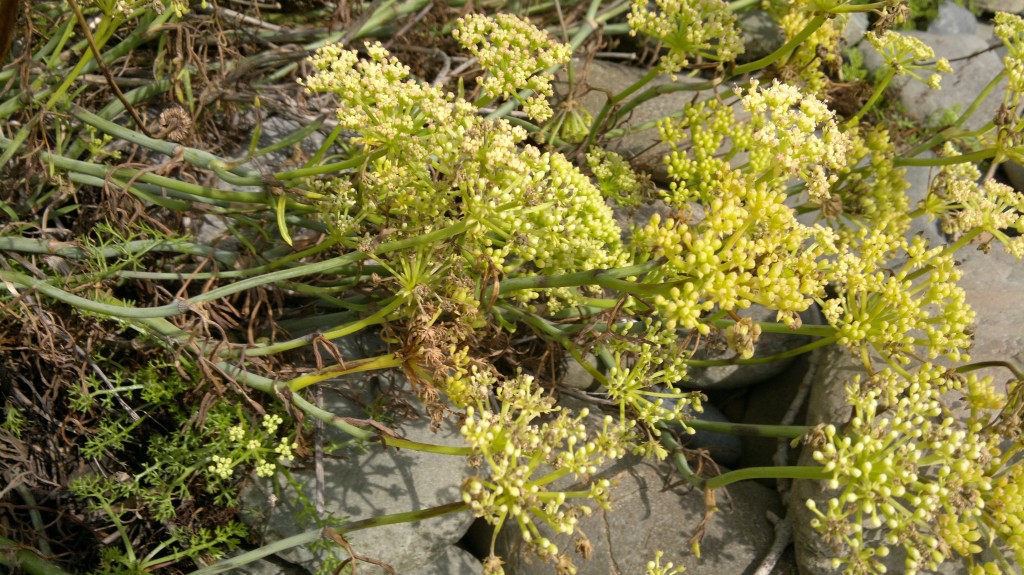
Rock samphire in flower and seed. Seeds are bitter and aromatic – great for making vermouths and cocktail bitters
If foraging conjures up images of bimbling along tranquil hedgerows, gently picking berries with a gentle sun on your back, then picking rock samphire may disabuse you of the notion. Though it does occasionally grow on the foreshore, its preferred home, clinging to precipitous coastal cliffs, makes for anything but bucolic harvesting. Most of my pictures are of it just out of reach as I cling nervously to a narrow ledge with waves breaking forebodingly below.
It is interesting that unrelated marsh samphire (a curiousity of the goosefoot family of plants), is now a fashionable wild vegetable while rock samphire can’t be bought for love or money. This wasn’t always the case, rock samphire being so popular up until the early 20th Century that it was regularly cut with less tasty and easier to harvest marsh samphire. The similarity between the two stops at their succulent, mini-cacti like appearance when trimmed and cooked or preserved. Marsh samphire is mostly salt and crunch (albeit in a delicious way), while rock samphire is salt, crunch and an intensely aromatic carrot/parsley flavour.
Rock samphire, like other strong-tasting wild foods, seems to receive more than its fair share of criticism for having too much flavour! While I can understand this – it really is quite pungent – I suspect palates stupefied by modern blandness and a lack of culinary imagination may also be to blame. Rather than chewing a mouthful raw and writing it off, why not steam, stir-fry, use sparingly in salads and sushi, or (its traditional, and possibly best preparation) pickle it? I love it pickled and served with smoked eggs and winkles and, most importantly, beer!
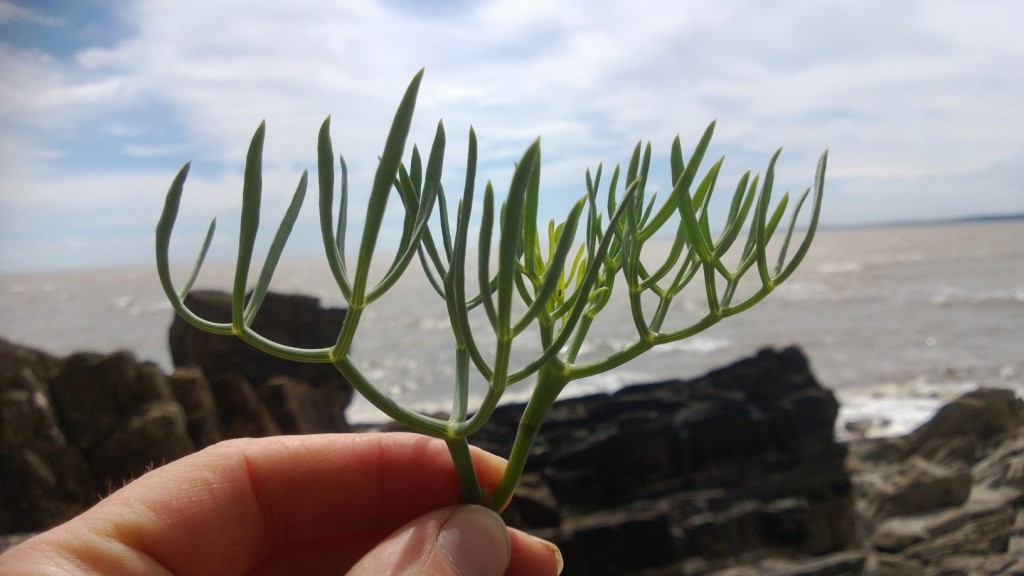
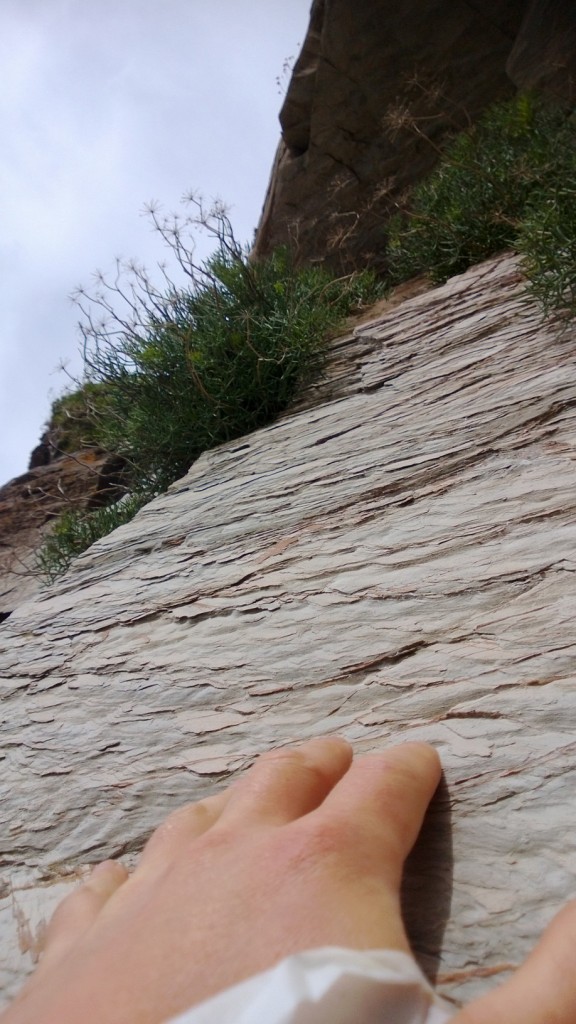
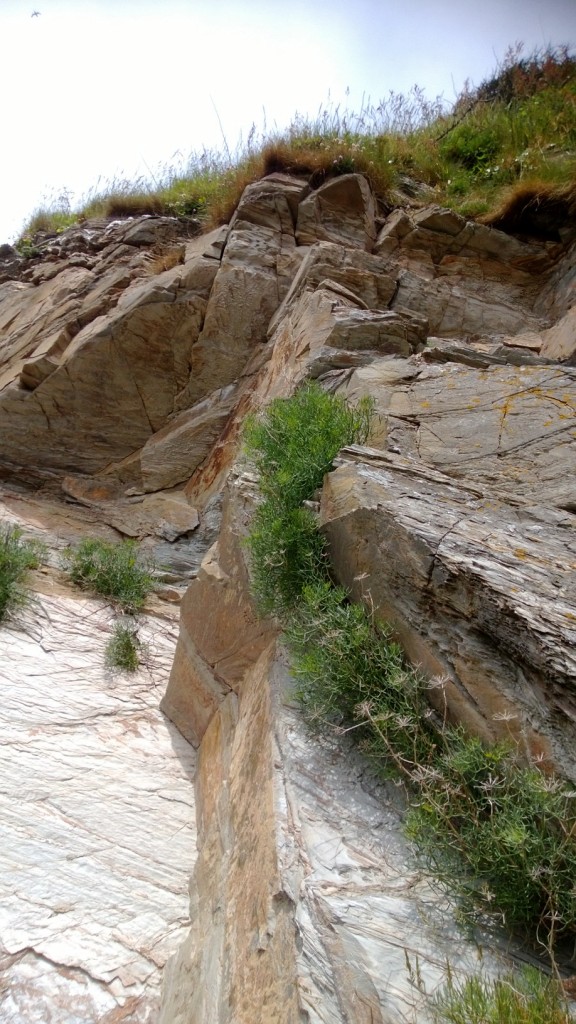
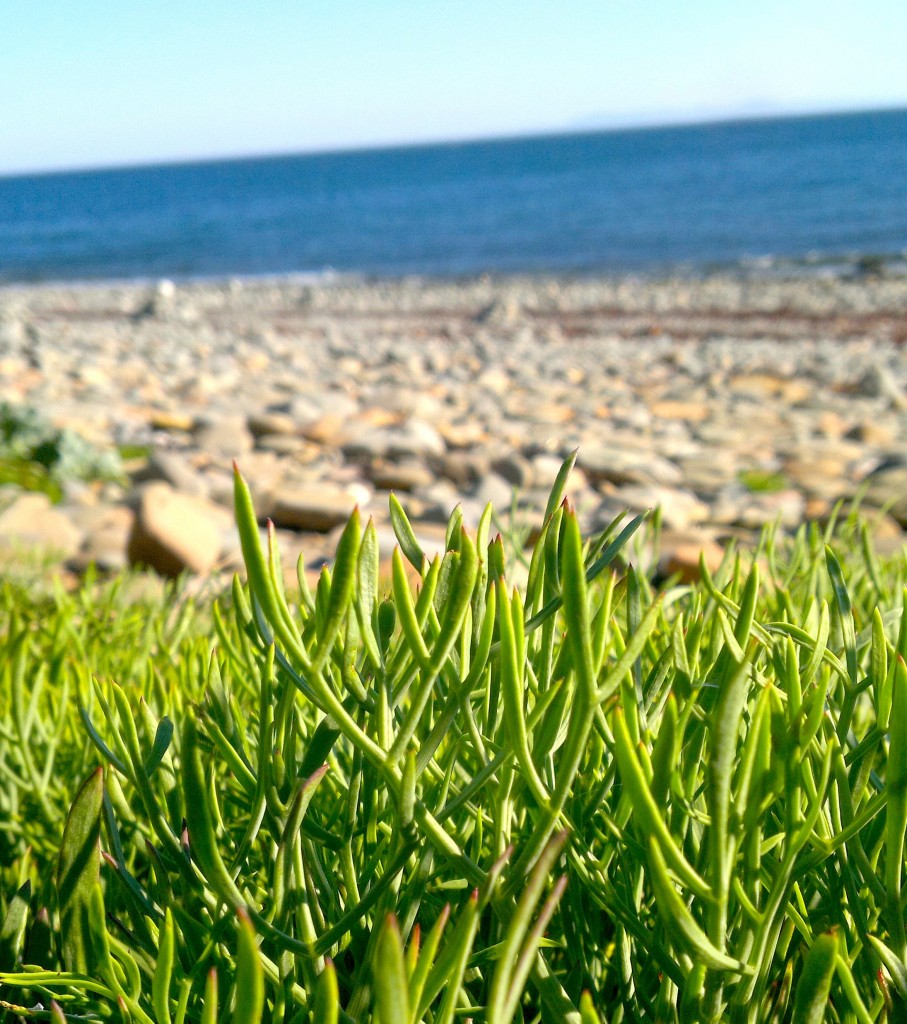
26 Comments
Good day
I would like to collect a few seeds of Crithmum maritimum. Can you tell me where I can find the plants in Galloway. ?
Thanks
Hi Duncan,
I don’t share locations for plants and fungi online for the reasons outlined here: http://www.gallowaywildfoods.com/?page_id=970
It sounds like you want a few seeds to grow, so my advice is to look on cliffs to the W of the region. I know of a few sites where it grows on the shore too, so not always a scary climb!
Happy hunting,
Mark.
Duncan, did you get the seeds of rock samphire? You can buy them at: http://www.chilternseeds.co.uk/item_413k_crithmum_maritimum_seeds
I have just picked a bagful at Lyme Regis in Dorset.
I went to find this today in Gower, Swansea. The first beach I went to – Brandy Cove – I found it straight away on the rocks there. Very easy. However its initial taste is very slightly aniseed(y). Since in North Gower you can pick Samphire – which I much prefer.
I’ll give this a go sauteed, and fried in butter with broad beans.
Photo of it here:
http://www.flickr.com/chrishc23
Hi Mark
I think I found quite a ready and accessible supply of this today in the south, on the foreshore. I just need to be absolutely sure. Looks as described and has a very pungent, somewhat oily (like kerosene) smell. How can I be sure? Don’t want to poison myself!
Sounds like it Vince. There isn’t much it can be mistaken for, in that habitat and with that smell. But only you can set the parameters of identification you need to be comfortable eating it.
I’m lucky enough to live where this stuff grows on the beaches and along the roadside in granite walls. Apart from having a little nibble and finding it tastes very similar to tea tree oil I have yet to cook with it.
Found it on rocks at Clonq Beach on Alderney. It looked like samphire so I tried it – delicious and as you say like aniseed. I’ll try some pickled.
Hi. This also grows freely in Southern Ireland, especially Cobh, in low coastal areas. – so no pearls of dangling from ledges to reach it 🙂 Going to try pickling it, just need a recipe.
Potato, leek, rock samphire, tarragon, and mixed fish/seafood bake, with cheesy creamy cornflour sauce over it all.
Ooh sounds lush.
I was in Malta last week and started munching on what I hoped was samphire, tased as reported and still alive. Would love to try your dish
I’ve brought some back from Gugh on the Isles of Scilly – about the Southernmost part of UK. Not too difficult to reach as there’s lots of rocky outcrops getting lashed by Atlantic spray. But I’m not sure if I’ve got Samphire or Sea Spray, (Suaeda maritima)?
Me again. Have really enjoyed this home-pickled in white wine vinegar. Develops the flavour nicely. Was also pleasantly surprised to find it growing on a cliff side in Crete! Of course I had a nibble!
Yes Vince, we have it all over Greece. After being introduced to it, Its hard to imagine my Greek Salad without it
Rock samphire is delicious, in my view just as good as marsh samphire, but like you say the flavour is more powerful and is difficult to describe because it’s so distinctive – lemon, salt, a hint of seaweed. The trick is to harvest it in spring/early summer before it gets tough. It is very common here in the south west UK. Simmer for a few minutes and add butter to serve with fish. Or add to soups or stews, or serve cold (but cooked) in salads (very good in salade nicoise).
By the way this is a great site, thank you.
I have a whole wall of this plant which is strangling a very old costal wild rose. I would like to get rid if it does anyone have any ideas?
Eat it?
I think you don’t know how to describe the taste just because where you leave. In Italy we eat a lot of Fennel during the summer and the Rock Samphire tastes exactly like fennel, this is why in Italian is called Finocchio di mare (Sea Fennel)
Excellent info Sara , I bought Samphire from Mayorca to the states, couldn’t find it here hopefully I find it soon
Great info here. I picked some in Ballycotton but was unsure if I had the right stuff until I read the comments. I most definitely pick up a smell of lemon, possibly lemon thyme and paraffin. Going to give it a go now. Steaming it after soaking in cold water overnight.
Do you cook it before pickling it, I have picked a lot here in West Wales.
I pour a boiling hot pickling solution over it, then leave to cool. So yes, that would be cooked, slightly.
I always eat it raw. Can’y imagine pouring boiling hot water on such a delicacy!
I eat it raw every day on my coastal walks around Cawsand, Cornwall where I live. I like the fact that it isnt bland…but then again, being a dedicated bushcrafter I eat lots of wild plants and animals so maybe I’m just used to natural flavours.
Just found lots on rocky beach Near Alicante can I pick now this time of year early October just contemplating my tea tonight, thank will it still be harvesting time thanks Dave